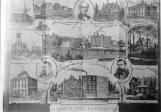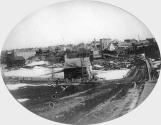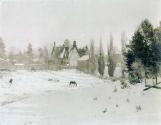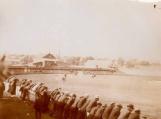1
AlmonteAlmonte is a town built on effort. From the first settlers to the current residents, hard work and enthusiasm are no foreign ideas. Even the name, "Almonte", is representative of enormous effort and devotion. In this case, General Juan Almonte was devoted to the liberation of Mexico in the face of American aggression. Being a compassionate community, and conveniently finding themselves in need of a name during the period of his fame, the citizens came together to officially name their village Almonte.
Prior to this decision, the area had been known by several different names. Originally, it had been called "Shepherds Falls" after the first settler, David Shepherd, a United Empire Loyalist who received a crown grant to build two mills along the banks of the Mississippi River. The loss of one mill to fire, and financial problems caused Shepherd to lose his grant. It was re-commissioned to Daniel Shipman, also a Loyalist, from Brockville. In 1822, Shipman had succeeded in building the requisite grist mill, and locally the area was known as "Shipman’s Mills."
3
On the other side of the river, Edward Mitcheson had built a grist mill and registered the official name of his land as "Victoriaville." On a map from 1855 the community was labeled "Ramsayville". In the meantime, the town’s post office existed throughout the various name changes under the title, "Ramsay." By 1856 the multitude of names had become too confusing. A town meeting was held to remedy the situation at which the name "Almonte" was chosen.From this point on, the community was inexhaustible in their efforts to build a thriving town. In 1874, Almonte boasted thirty stores and thirty five other businesses. The town was commonly regarded as "The Manchester of Canada," for it’s advancement and status as a leader in the textile industry.
The same enthusiasm and effort put into creating this great community was transferred to the playing fields. There were innumerable teams and games played with vigor and passion all throughout the community. There were, of course, rivalries between this town and it’s neighbours, adding all the more to the drama and excitement of it all.
5
Gemmil ParkGemmil Park, a true testament to the devotion to physical activity in the town. At any time, in any season you will find someone in the Park. Tennis courts, track, soccer fields, football field, play structure, baseball diamond, horshoe pits,
basketball courts and the recently added skateboard ramp. The hills beyond the tennis court are the site of winter fun; sledding here is the ultimate.
John Gemmil, prominent town citizen, once owned a stately home and farm where the park is today. After his death, the property passed to his daughter Winifred Gemmil. Upon her death in 1943 the farm or Homestead was bequeathed to the town of Almonte that they might "construct, establish and maintain a Public Park or Recreation Ground."
Today Gemmil Park is most frequented by soccer enthusiasts. Our residents are soccer fanatics and the increase in the number of players and teams in Almonte is staggering.
8
Prior to this park being established numerous other sites through out the town had been used as playgrounds. The most used field in town was the N.L.A.S (North Lanark Agricultural Society ) grounds on Water Street in Almonte. The field was large and the grandstands provided good seats for spectators.In the 1920’s and 1930’s sporting events were typically played on McCallum’s Sports Field.
10
Almonte Cricket ClubCricket was very popular and evidence of the Almonte Cricket Club dates to 1862. The Express, predecessor of the Gazette, our local newspaper, reported numerous cricket related details:
May 9th 1862 Express
Almonte Cricket Club rolling and sodding of the pitch with play to be held twice a week, invitation to new members opening game of the season to be May 17, 1862. Also an advertisement for a meeting of the Almonte Cricket Club.
The cricket grounds were at that time located at the rear of the B&O Railway Depot (Brockville and Ottawa Line)
Friday May 30th 1862 Express
"The Queen’s Birthday - Saturday last was generally observed in this village as a public holiday… About 10 o’clock a.m., the Cricket Club turned out for a practice on the cricket ground where they remained until noon. At 2 o’clock pm they returned, but having no other club to play against them, not even the "All England Eleven". Sides were chosen and a match was played between themselves, creating a good deal of excitement and amusement among the large number of spectators on the ground."
Friday May 28th, 1870 Almonte Gazette
"The 24th - Queen’s Birthday - A greater crowd went to Arnprior where a great deal was to see. A procession of firearms, games, footraces and free whiskey made the morning interesting. While the afternoon was filled by lacrosse, cricket and the "TERRIBLES". Altogether the celebration in Arnprior was very creditable to the managers."
12
The games were typically played on the fairgrounds where spectators could watch in the grandstands. The ACC (Almonte Cricket Club) was one of the teams active in the Ottawa Valley Cricket Council. Teams would play every Saturday. Christ Church Cathedral in Ottawa had a team and they were remembered by Stan Morton as a pretty good team. "All around the players were a great group of guys and a lot of fun was had." Walter Morton, Stan’s father, was an "average player, but the Captain of the team the year they won the cup."Lawrence Woodhead, Lorrie as he was known, was an excellent player, "a cracker of a bowler". The bowlers were the most important members of the team and consequently they would practice hard. The rest would just bat and throw the ball around in practice.
The season opened in June and would run through August. Playoffs would begin in September. Stan remembers one memorable May when a group of club members had taken a day off to help get the pitch ready for play. They had come out with thier lawn mowers ready to work only to be interrupted by four inches of snow.
Players in the early days would travel by train to away games. With the advent of the automobile, the team would take a few cars to a match. "Alf Jackman and Claude Thompson had cars" so the team often piled into the two vehicles. It was quite a feat to haul the team up Bay Hill and they would make sure to get a good run at it.
13
The Almonte Cricket Club. Winners of the 1925 Ottawa Valley Cricket League Championship.1925
Almonte
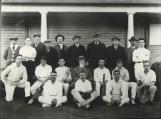
14
In the mid 1930’s the team disbanded as interest waned. In its place the lawn bowling club was formed, a group that still plays to this day. The cricket house was moved to Robert Street to be used as the lawn bowlers club house and it still stands today.These memories were told by Stan Morton, born in Almonte in 1905. The son of Walter Morton, Rosamond Mill worker. Stan is a legend in this town and served as Almonte’s ambassador for many years. His store on main street was always a hub of activity. It was the place for news, toys, candy, you name it, he had it. "Almonte is a great town, none better."
Stan was born on Farm Street, lived on Farm Street and still owns his house on Farm Street "a true Farm Streeter". Farm Street was ideally located two minutes from the Rosamond Woolen Mill, where he and his father worked for many years.
